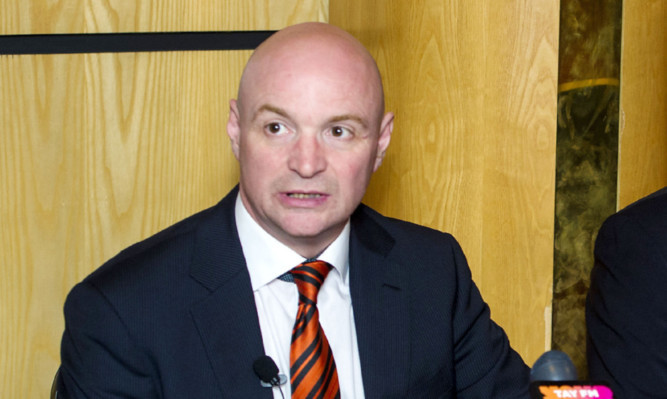The financial threat posed to Dundee United by possible relegation has been highlighted in the club’s strategic report.
Part of the wider “Report and financial statements 2015” submission made to Companies House, the strategic report relates to the club’s position as of February 20 of this year.
It was prepared and approved by the board of directors and signed on their behalf by chairman Stephen Thompson.
United currently sit bottom of the Ladbrokes Scottish Premiership, seven points adrift of second-bottom Kilmarnock with a game in hand and eight league fixtures remaining.
The report stresses that: “The short-term aim is to preserve the club’s Premiership status.”
However, in the section entitled “Going concern” the likely impact of dropping out of the top flight at the end of the season is addressed by the Tannadice board, as well as other economic concerns.
The report states: “The current league position of the football team, together with general economic and other conditions, create uncertainty in a number of areas including:
* the likely SPFL prize monies for the current season, which will depend on the team’s final league position;
* whether the club will compete in the Premiership or the Championship in season 2016/17, which would be expected to significantly impact prize monies, gate receipts and television revenues;
* the effect that this could have on the company’s attractiveness to potential investors and lenders as well as sponsors and corporate customers;
* the potential income from a successful run in the Scottish FA Cup;
* the likelihood of contingent receipts crystallising in respect of previous player transfers.”
The report adds that the directors have planned for “a number of scenarios” and that certain forecasts indicated that “there will be a significant additional funding requirement in the next 12 months.”
It stresses that the reason for this is “principally as a consequence of the direct impact on income of the current league position, the costs of changing the football management team during 2015, together with the early repayment of loan notes in the second half of 2015.”
The report goes on to say that the extra funding requirement is “based on the assumption that none of the potential additional income opportunities materialise” and that the exact amount of cash that would be needed under those circumstances is “uncertain.”
United, however, are already talking to “a number of existing lenders, shareholders, intermediaries and other third parties” to explore funding options.
With these discussions already under way, the reports stresses that the Tannadice board are “confident that a course of action will be agreed that is mutually acceptable to the company, its shareholders and its lenders that would enable the company to raise any additional funding required, although it is recognised that this may not be finalised for several months.”
Then comes a bleak warning, before some reassurance that the club will able to cope financially.
The reports states: “The combination of these circumstances, including the potential need to secure additional funding, represents a material uncertainty that may cast significant doubt upon the company’s ability to continue as a going concern and, therefore, its ability to realise its assets and discharge its liabilities in the normal course of business.”
There is a more upbeat conclusion, however.
It adds: “That said, after making enquiries and considering the uncertainties described above, the directors have a reasonable expectation that the company will have adequate resources to continue in operational existence for the foreseeable future. For these reasons, they continue to adopt the going concern basis.”
In the period to June 30, 2015, covered by the “Report and financial statements 2015”, United made a yearly profit of £3,943,976 – the largest in its history.
It compared to the previous year’s figure of £1,218,379.
The Tangerines also increased revenues year on year by 4% to £5,816,475.
However, they still made an operating loss for the period of £798,816, compared to the 2014 figure of £114,335.
The report conceded that: “Such losses can only be sustained by successful player trading, and there is no guarantee of such impressive gains in future years.
“Much work is being done to continue identifying and implementing reductions in operating expenses and wages, and the value of this work is likely to be reflected in forthcoming results.”
What will help the club’s coffers is the income, not included in these accounts, from the sales of Nadir Ciftci to Celtic, John Souttar to Hearts and Ryan McGowan to Chinese club Henan Jianye.
A note to the financial statement adds: “The directors anticipate that the 2016 profit on these transfers will be approximately £1,2 million.”
